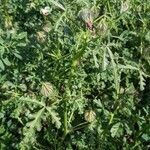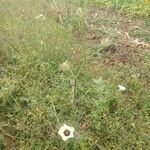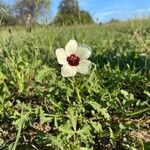Herbs annual, erect or procumbent, 25-70 cm tall; stems slender, white stellate hirsute. Stipules filiform, ca. 7 mm, stellate coarsely hirsute; petiole 2-4 cm, stellate hirsute and stellate puberulent; leaf blade 3-6 cm in diam., dimorphic; blades on proximal part of stem orbicular, those on distal part of stem palmately 3-5-lobed, central lobe longer, lateral lobes shorter, lobes obovate to oblong, usually pinnate, sparsely stellate spiny hairy abaxially, sparsely hirsute or glabrous adaxially. Flowers solitary, axillary. Pedicel ca. 2.5 cm, elongated to 4 cm in fruiting, stellate hirsute. Epicalyx lobes 12, filiform, connate at base, ca. 8 mm, hirsute. Calyx greenish, campanulate, swollen, connate for ca. 1/2 length, 1.5-2 cm, membranous, long hirsute or stellate hirsute, lobes 5, triangular, longitudinally purple-veined. Corolla very pale yellow with purple center, 2-3 cm in diam.; petals 5, obovate, ca. 2 cm, abaxially sparsely very minutely puberulent. Staminal column ca. 5 mm; filaments slender, free for ca. 3 mm; anthers yellow. Styles 5, glabrous. Capsule oblong-globose, ca. 1 cm in diam., coarsely hirsute; mericarps 5, endocarp black, thin, exocarp papery. Seeds black, reniform, glandularly verrucose. Fl. Jul-Oct.
Annual or biennial herb up to 0.5 m high, not armed. Stems moderately to densely clothed in stellate hairs when young, becoming ± glabrous. Lvs sparsely hairy with simple and stellate hairs; lower lvs suborbicular and entire to coarsely serrate; stem lvs palmately 3-5-lobed, 1-6 cm long; segments serrate to pinnatifid; petioles 5-15-(30) mm long; stipules linear, 3-8 mm long, persistent. Fls solitary and axillary, or 1-3 and pseudoterminal; epicalyx segments (8)-10-13, free ± to base, linear-lanceolate; calyx campanulate; calyx teeth ovate-triangular, = or somewhat < tube, membranous, with long, few-rayed stellate hairs on veins and margins, scattered short many-rayed stellate hairs on teeth, and short simple hairs within. Petals white to pale yellow, with dark brown, red, purplish or orange markings at base, c. 20-40 mm long. Capsule separating into 5 cells at dehiscence, loosely enclosed by calyx. Seeds brown, papillate, 2-2.5 mm long.
Annual herb, 0.1-1.5 m high; stems stellate-pubescent. Leaves ± suborbicular in outline, deep palmately 3-5-lobed (sometimes palmatisect), lobes ± obcuneate, apex rounded, margins pinnately incised, base truncate to shallowly cordate. Flowers axillary; peduncles up to 55 mm long. Epicalyx bracts 12, filiform. Calyx 5-lobed, lobes united almost to apex, scarious with purplish, longitudinal veins, becoming inflated. Petals obovate, white, cream-coloured or yellow, purple-centred. Staminal tube 3-4 mm long. Flowering time Oct.-Apr. Fruit a capsule, completely surrounded by inflated calyx. Seeds subreniform, tuberculate.
Annual to biennial ± hispid herb up to ± 4 dm. tall; lower branches spreading to prostrate, upper us. ascending. Lvs on petioles ± 5-10 mm. long. Lamina ± 2-8 cm. diam., suborbicular, cordate; of lower lvs rather shallowly 3-5-lobed, of mid and upper lvs more deeply cut, segs narrow, coarsely toothed. Fls axillary, ± 3-5 cm. diam., on peduncles ± 2-5 mm. long. Bracteoles 7-12, linear, hispid; calyx ± 2 × 2 cm., membr., inflated, with raised hispid veins. Petals white to pale yellow, with dark brown base. Capsule subglobose, hairy, enclosed in calyx. Seeds glab., dark brown, subreniform ± 3 mm. long.
An annual herb. It can be erect or lie over. It is 25-70 cm high. The leaves are alternate. The leaf stalk is 2-4 cm long. The leaf blade has 3-5 lobes arranged like fingers on a hand. The leaf blade is 3-6 cm across. The central lobe is longer. The leaf blade is covered with coarse star like hairs. The flowers occur singly in the axils of leaves. They are yellow and purple at the base. They are like a Hibiscus flower. The fruit is a capsule which is about 1 cm across. It is a hairy five celled capsule. There are many black seeds.
Branching, hairy annual 3–5 dm; lvs long-petioled, deeply 3-parted, the segments oblong to obovate, coarsely serrate or lobed; cal conspicuously veined, hispid on the nerves with spreading simple hairs from swollen bases; pet 1.5–4 cm, pale yellow with purple base, expanded only a few hours; mature cal inflated, 5-angled, enclosing the hirsute fr; seeds finely verrucose; 2n=28, 56. Native of s. Europe; fields, roadsides, and waste places from N.S. to Minn., s. to Fla. and Tex. July–Sept.
Annual herb, up to 1.5 m high. Stems straggling; sparsely hairy. Leaves with blade usually deeply 3-5-lobed, ± 70 x 60 mm, margins toothed to lobed. Flowers: solitary; epicalyx with 12 segments; calyx papery, veins green to purple; corolla 20-40 mm in diameter; petals 20-30 mm long, white to cream-coloured with a deep red centre, closing by early afternoon; Oct.-Jun. Fruit with calyx becoming inflated, enclosing fruit.
Leaf-lamina 2–6 × 2–6 cm., suborbicular to ovate in outline (or hastate but not apparently in our area), varying from not lobed to deeply 3–5-palmatilobed or incised, hispid on the nerves, apex rounded, base truncate to slightly cordate, 3–5-nerved, lobes pinnately incised; petiole 1–4 cm. long, hairy like the young stems; stipules 4–8 mm. long, linear.
Stiffly hairy annual. Leaves mostly 3-5-palmatisect, toothed. Flowers pedunculate in upper axils, whitish or pale yellow with dark eye, epicalyx of 10-12 linear lobes, calyx bell-shaped, purple-veined, swollen in fruit, staminal tube 3-4 mm long; seeds tuberculate.
Stiffly hairy annual, up to 1.5 m tall. Leaves mostly 3-5-palmatisect, toothed. Flowers pedunculate in upper axils, yellow with dark eye, epicalyx of 21-25 mmear lobes, calyx bellshaped, purple-veined, swollen in fruit.
Annual herb, up to 1.5 m high. Calyx inflated, scarious, enclosing capsule, lobes connate nearly to apex. Flowers white, cream or yellow with purple centres.
Flowers 2·5–4 cm. in diam., white, cream or yellow, with purple centres, solitary, axillary; peduncle up to 5·5 cm. long, hairy like the young stems.
Calyx up to 2·5 cm. long, scarious with purplish longitudinal veins, stellate-pilose or hispid, becoming inflated; lobes united nearly to the apex.
Annual herb up to 1·5 m. tall; young stems stellate-pubescent to stellate-tomentose or hispid.
Staminal tube 3–4 mm. long, somewhat glandular; free parts of filaments 3–4 mm. long.
Capsule 10–14 mm. in diam., subglobose, hispid, enclosed in the inflated calyx.
Epicalyx of 12 bracts; bracts 7–14 mm. long, filiform, often hispid.
Petals 2–3 × 1·5–3 cm., obovate, nearly glabrous.
Seeds 2 × 1·5 cm., subreniform, tuberculate.
Flowers yellow with a purple centre.
Much-branched hispid annual
Style-branches 2 mm. long.











